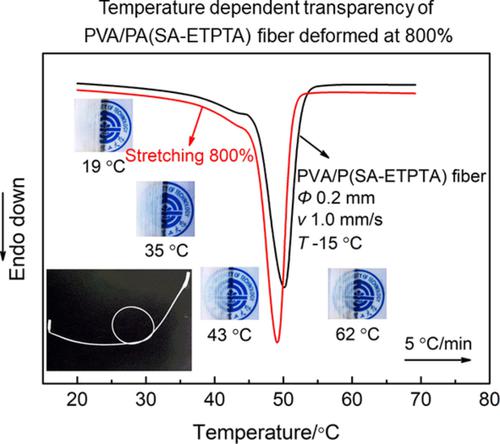当前位置:
X-MOL 学术
›
J. Appl. Polym. Sci.
›
论文详情
Our official English website, www.x-mol.net, welcomes your
feedback! (Note: you will need to create a separate account there.)
A poly(vinyl alcohol)/poly(stearyl acrylate) core-shell fibers with robust performance realized by taking advantages of the phase change property
Journal of Applied Polymer Science ( IF 2.7 ) Pub Date : 2021-10-18 , DOI: 10.1002/app.51794 Meijie Qu 1 , Hai Wang 1 , Nan Zheng 2 , Qiushan Chen 1 , Ping Tang 1 , Yuezhen Bin 1
Journal of Applied Polymer Science ( IF 2.7 ) Pub Date : 2021-10-18 , DOI: 10.1002/app.51794 Meijie Qu 1 , Hai Wang 1 , Nan Zheng 2 , Qiushan Chen 1 , Ping Tang 1 , Yuezhen Bin 1
Affiliation

|
A phase change fiber with long-term stability, temperature dependent transparency and melt-healing properties were prepared using polyvinyl alcohol (PVA) as the shell layer and polystearyl acrylate (PSA) lightly crosslinked by ethoxylated trimethylolpropane triacrylate (ETPTA) as the core layer. It was found the PVA/P(SA-ETPTA) core-shell fiber exhibited a melt enthalpy of 43 J/g (coagulation bath temperature −15 °C, core layer diameter 0.2 mm, spinning rate 1.0 mm/s) and an extremely high stability after 100 heating–cooling cycles. The as-spun core-shell fiber was fragile, but the flexibility was greatly improved after it was drawn to 800% of the original length. The PVA shell forming tunneling for the P(SA-ETPTA) core layer, which could heal after fracture on condition of PSA melting. The melting and crystallization of PSA side chains enabled a temperature dependent light transmittance of the PVA/P(SA-ETPTA) fibers, which was ascribed to the phase separation between PSA and PETPTA around the melting point of the PSA composition. As a whole, the core-shell fibers showed robust performance as a phase change fiber. Further aggregate structure and orientation structure investigation on the PVA/P(SA-ETPTA) fiber was detected by wide angle X-ray diffraction and small angle X-ray scattering.
中文翻译:

利用相变特性实现了具有稳健性能的聚(乙烯醇)/聚(丙烯酸硬脂酯)核壳纤维
以聚乙烯醇(PVA)为壳层,以乙氧基化三羟甲基丙烷三丙烯酸酯(ETPTA)轻度交联的聚丙烯酸硬脂酯(PSA)为芯层,制备了一种具有长期稳定性、温度依赖性透明性和熔体愈合性能的相变纤维。发现 PVA/P(SA-ETPTA) 核壳纤维的熔体焓为 43 J/g(凝固浴温度 -15 °C,芯层直径 0.2 mm,纺丝速率 1.0 mm/s)和极100 次加热-冷却循环后具有高稳定性。初纺的核壳纤维易碎,但拉伸至原长度的800%后柔韧性大大提高。P(SA-ETPTA)芯层的PVA壳形成隧道,在PSA熔化的条件下可以在断裂后愈合。PSA 侧链的熔化和结晶使 PVA/P(SA-ETPTA) 纤维的光透射率具有温度依赖性,这归因于 PSA 和 PETPTA 之间在 PSA 组合物熔点附近的相分离。总的来说,核壳纤维作为相变纤维表现出强大的性能。通过广角 X 射线衍射和小角 X 射线散射检测 PVA/P(SA-ETPTA) 纤维的进一步聚集结构和取向结构。
更新日期:2021-12-13
中文翻译:

利用相变特性实现了具有稳健性能的聚(乙烯醇)/聚(丙烯酸硬脂酯)核壳纤维
以聚乙烯醇(PVA)为壳层,以乙氧基化三羟甲基丙烷三丙烯酸酯(ETPTA)轻度交联的聚丙烯酸硬脂酯(PSA)为芯层,制备了一种具有长期稳定性、温度依赖性透明性和熔体愈合性能的相变纤维。发现 PVA/P(SA-ETPTA) 核壳纤维的熔体焓为 43 J/g(凝固浴温度 -15 °C,芯层直径 0.2 mm,纺丝速率 1.0 mm/s)和极100 次加热-冷却循环后具有高稳定性。初纺的核壳纤维易碎,但拉伸至原长度的800%后柔韧性大大提高。P(SA-ETPTA)芯层的PVA壳形成隧道,在PSA熔化的条件下可以在断裂后愈合。PSA 侧链的熔化和结晶使 PVA/P(SA-ETPTA) 纤维的光透射率具有温度依赖性,这归因于 PSA 和 PETPTA 之间在 PSA 组合物熔点附近的相分离。总的来说,核壳纤维作为相变纤维表现出强大的性能。通过广角 X 射线衍射和小角 X 射线散射检测 PVA/P(SA-ETPTA) 纤维的进一步聚集结构和取向结构。

















































 京公网安备 11010802027423号
京公网安备 11010802027423号